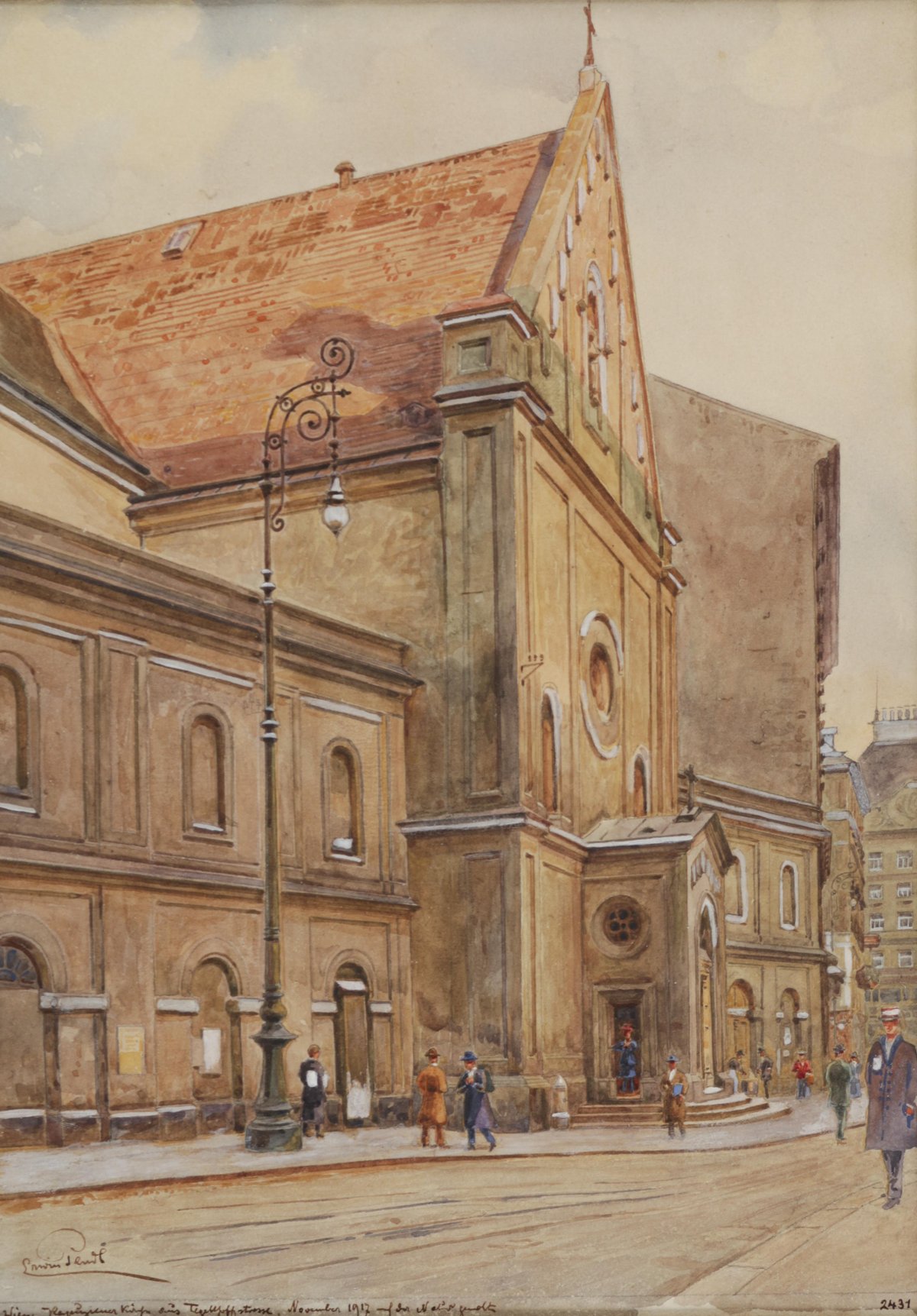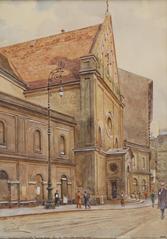
Capuchin Church Vienna: Visiting Hours, Tickets, and Comprehensive Tourist Guide
Publication Date: 14/06/2025
Introduction
Nestled in Vienna’s historic city center, the Capuchin Church (Kapuzinerkirche), officially the Church of Saint Mary of the Angels, stands as a profound symbol of Austria’s imperial legacy and spiritual heritage. Renowned for its simple yet elegant Baroque architecture and its role as the home of the Imperial Crypt (Kaisergruft)—the principal burial site of the Habsburg dynasty—the church offers a unique blend of history, art, and contemplation. Visitors can expect both an architectural gem and a site of deep dynastic significance, with over 150 members of Europe’s most influential royal family interred beneath its sanctuary.
This comprehensive guide details the church’s origins, architectural evolution, the importance of the Imperial Crypt, and essential visitor information—ensuring you make the most of your experience at one of Vienna’s most meaningful landmarks. For up-to-date details, refer to official resources such as the Capuchin Church official site, Vienna tourism, and the Imperial Crypt visitor information. (awesomevienna.at, spottinghistory.com, allaboutvienna.com)
Table of Contents
- Introduction
- Origins of the Capuchin Order and Arrival in Vienna
- Foundation and Construction of the Capuchin Church
- The Imperial Crypt: A Dynastic Mausoleum
- Architectural and Artistic Features
- The Capuchin Monastery: Spiritual and Social Mission
- Visiting Information: Hours, Tickets, Accessibility, and Tours
- Concerts and Cultural Events
- Nearby Attractions
- Frequently Asked Questions (FAQ)
- Conclusion & Key Recommendations
- Sources and Further Reading
Origins of the Capuchin Order and Arrival in Vienna
The Capuchin Order, an offshoot of the Franciscan movement, was established in Italy in 1528, centering on the ideals of simplicity, humility, and service to the poor. The Capuchins first arrived in Vienna in 1599, initially passing through as part of the Catholic Counter-Reformation. Their presence soon became integral to the city’s spiritual life, especially as the Habsburgs sought to strengthen Catholicism in their territories. (awesomevienna.at, spottinghistory.com)
Foundation and Construction of the Capuchin Church
The church’s establishment was made possible by Empress Anna of Tyrol, who, in her will, allocated funds specifically for building a Capuchin church and monastery in Vienna—a personal and political testament to her faith. Construction began in the early 17th century but faced delays due to the Thirty Years’ War. Ultimately, the church was completed and consecrated in 1632, dedicated to the Immaculate Conception, and it has since remained an enduring center of worship and reflection. (awesomevienna.at, spottinghistory.com)
The Imperial Crypt: A Dynastic Mausoleum
Beneath the Capuchin Church lies the Imperial Crypt (Kaisergruft), one of Europe’s most significant dynastic burial sites. Established through Anna of Tyrol’s bequest, the crypt has served as the resting place for the Habsburg family since 1633, with over 150 entombments including 12 emperors and 19 empresses. The crypt’s artistic and historical significance is immense, featuring sarcophagi ranging from grand Baroque masterpieces—such as the tomb of Empress Maria Theresa—to the austere coffin of Emperor Joseph II. The Imperial Crypt is a living chronicle of Austria’s transformation through centuries of political and cultural change. (viennatouristinformation.com, spottinghistory.com)
Architectural and Artistic Features
Exterior Architecture
The Capuchin Church is distinguished by its modest, unassuming Baroque façade, embodying the order’s values of humility. A round window above the entrance and a simple terracotta cross contribute to its understated dignity. Renovations in the 20th century restored early Baroque elements while preserving the church’s original character. (allaboutvienna.com, visitingvienna.com)
Interior Layout
Inside, the rectangular nave with white vaulted ceilings and plain walls fosters a tranquil, contemplative atmosphere. The main altar, built in 1735, features inlaid woodwork and a central painting of St. Francis of Assisi’s Portiuncula vision. Delicate ceiling frescoes and natural light create a harmonious interplay between art and architecture. (audiala.com, allaboutvienna.com)
Notable Chapels and Memorials
- Pietàkapelle: Houses a moving Baroque altar and marble statuary of the mourning Virgin Mary.
- World War I Memorials: Discreetly commemorate Austria’s modern history.
The Imperial Crypt
Accessed via glass doors near the main entrance, the crypt’s architecture and artistry range from ornate Baroque to Neo-Classical and modern. Notable tombs include those of Empress Elisabeth (“Sisi”), Emperor Franz Joseph I, and Maria Theresa. The crypt’s funerary art and inscriptions reflect both personal stories and broader historical epochs. (travelnotesandbeyond.com, thebettervacation.com)
The Capuchin Monastery: Spiritual and Social Mission
Adjacent to the church, the Capuchin Monastery has long been a hub of religious and social activity in Vienna. The friars are dedicated to prayer, spiritual guidance, and charitable work—values that have defined the order for centuries. The monastery’s courtyards and chapels offer a serene retreat in the heart of the city, while community outreach continues to support Vienna’s vulnerable populations. (awesomevienna.at)
Visiting Information: Hours, Tickets, Accessibility, and Tours
Opening Hours
- Church: Monday–Saturday: 9:00 AM–6:00 PM; Sunday & public holidays: 1:00 PM–6:00 PM.
- Imperial Crypt: Daily, 10:00 AM–6:00 PM (last admission at 5:30 PM). (allaboutvienna.com, kapuzinerkirche.at)
Tickets and Prices
- Church: Free entry.
- Imperial Crypt (as of June 2025):
- Adults: €13
- Concessions (seniors 60+, students under 27, disabled): €11
- Children under 19: €7
- Family Ticket (2 adults + children): €29.50
- Combo-Ticket (Crypt + Concert): Adults €46, Seniors €37, Youth (under 27) €30
- Tickets can be purchased online or at the entrance. (kunst kultur)
Accessibility
- Church: Generally accessible, though some areas have steps or uneven floors. Assistance available on request.
- Crypt: Limited accessibility due to stairs; contact staff for arrangements. (theviennablog.com)
Guided Tours and Audio Guides
- Tours in multiple languages and audio guides are available for an enhanced experience. Book in advance during peak seasons. (viennatouristinformation.com)
Dress Code and Etiquette
- Modest attire required; cover shoulders and knees. Silence is expected inside both church and crypt. Photography is allowed in the church (no flash) but prohibited in the crypt.
Concerts and Cultural Events
The Capuchin Church hosts classical concerts, including “A Little Night Music” on select evenings. These events allow visitors to enjoy Vienna’s musical heritage in a unique, historical setting. Combo-tickets are available for concerts and crypt visits. (kunst kultur)
Nearby Attractions
Enhance your visit by exploring nearby Vienna landmarks:
- Hofburg Palace
- St. Stephen’s Cathedral
- Albertina Museum
- Kärntner Strasse shopping district
All are within walking distance and easily accessible by public transport.
Frequently Asked Questions (FAQ)
Q: What are the Capuchin Church and Imperial Crypt opening hours?
A: The church is open Monday–Saturday 9:00 AM–6:00 PM, Sunday/public holidays 1:00 PM–6:00 PM. The crypt is open daily 10:00 AM–6:00 PM.
Q: How much are tickets for the Imperial Crypt?
A: Adult tickets are €13; concessions and family tickets are available. Entry to the church is free.
Q: Is the site wheelchair accessible?
A: The church is mostly accessible; the crypt has limited accessibility. Contact staff for assistance.
Q: Are guided tours or audio guides available?
A: Yes, both are offered in several languages.
Q: Can I take photos inside?
A: Photos are permitted in the church without flash; photography is not allowed in the crypt.
Q: What is the best time to visit?
A: Early mornings or late afternoons on weekdays are less crowded.
Conclusion & Key Recommendations
The Capuchin Church and Imperial Crypt offer a profound journey into the heart of Vienna’s imperial and spiritual history. Their blend of austere architecture, rich funerary art, and dynastic legacy make them essential stops for any visitor. Plan your visit by checking up-to-date hours and ticketing information, consider a guided tour or concert for added insight, and take time to explore the surrounding historic center.
For the latest updates and visitor resources, consult the official Capuchin Church website, the Imperial Crypt page, and Vienna’s tourism portals. To enrich your experience, download the Audiala app for immersive audio guides and follow related social media channels for ongoing updates.
Sources and Further Reading
- Capuchin Church Vienna: History, Visiting Hours, Tickets & Visitor Guide
- Capuchin Church and Imperial Crypt
- Capuchin Church Vienna: Visiting Hours, Tickets, and Architectural Highlights
- Imperial Crypt (Kaisergruft) Visiting Hours, Tickets & Guide
- Capuchin Church Vienna Visiting Hours, Tickets, and Visitor Guide
- Visitor Experience and Practical Tips
- Audiala App and Vienna Historical Sites






















































































































































